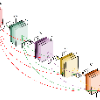Densely connected convolutional networks (DenseNet) behave well in image processing. However, for regression tasks, convolutional DenseNet may lose essential information from independent input features. To tackle this issue, we propose a novel DenseNet regression model where convolution and pooling layers are replaced by fully connected layers and the original concatenation shortcuts are maintained to reuse the feature. To investigate the effects of depth and input dimension of proposed model, careful validations are performed by extensive numerical simulation. The results give an optimal depth (19) and recommend a limited input dimension (under 200). Furthermore, compared with the baseline models including support vector regression, decision tree regression, and residual regression, our proposed model with the optimal depth performs best. Ultimately, DenseNet regression is applied to predict relative humidity, and the outcome shows a high correlation (0.91) with observations, which indicates that our model could advance environmental data analysis.
翻译:在图像处理过程中,连接程度紧密的革命网络(DenseNet)在图像处理中表现良好,然而,对于回归任务,进化的DenseNet可能会失去独立输入功能中的基本信息。为了解决这一问题,我们提议了一个新型的DenseNet回归模型,以完全连接的层取代进化和集合层,并保留最初的连接捷径来重新利用该功能。为了调查拟议模型的深度和输入层面的影响,通过广泛的数字模拟进行仔细验证。结果提供了最佳深度(19),并建议了有限的输入层面(200以下)。此外,与基线模型相比,我们提议的具有最佳深度的模型表现最佳。最终,DenseNet回归用于预测相对湿度,结果显示与观测的高度相关性(0.91),这表明我们的模型可以推进环境数据分析。




